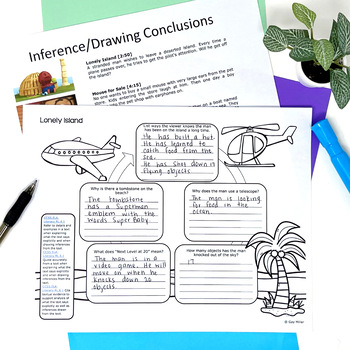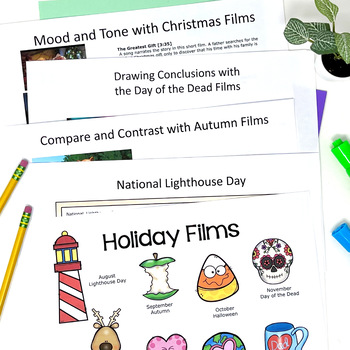Teaching with Animated Short Films All in One Reading & Writing MEGA Bundle
- Zip
- Google Apps™

What educators are saying
Products in this Bundle (12)
showing 1-5 of 12 products
Bonus
Description
If you are looking to add some high interest activities to your lessons, try using animated shorts to teach reading and writing skills. This packet contains graphic organizers covering many Common Core skills. $Save$ when you purchase this mega bundle which includes all 6 units.
Part 1 – READING AND WRITING
Inference and Drawing Conclusions
Summarizing
Main Idea and Supporting Details
Perspective and Point of View
Theme
Character and Setting
Cause and Effect
Compare and Contrast
Problems and Solutions
Holiday Films
Story Mapping – Paraphrasing Information (National Lighthouse Day)
Compare and Contrast (Autumn)
Descriptive Writing (Halloween)
Drawing Conclusions (Day of the Dead)
Mood and Tone (Christmas)
Dialogue (Valentine’s Day)
Planning an Opinion or Argumentative Writing (Earth Day)
Comprehension (Father’s Day)
Part 2 – READING AND WRITING
RL.1 – Inference/Drawing Conclusions/Prediction/Details
RL.2 – Summarizing/Paraphrasing/Main Idea and Supporting Details/Theme
RL.3 – Description of Characters and Setting/Character Change/Types of Conflict
RL.4 – Word Choice/Figurative Language
RL.5 –Structural Elements/Problem and Solution/Cause and Effect/ Chronology/ Comparison
RL.6 – Perspective and Point of View/Irony
RL.7 – Visual and Multimedia Elements/Mood and Tone
RL.9 – Compare and Contrast
Part 3 - CHRISTMAS
This new addition covers the same skills as above plus Comparing Firsthand and Secondhand Accounts. The forty-three films are divided by theme:
· Gift Giving
· The Christmas Truce of 1914 / World War I
· Stars
· Animals
· Santa
· Classics
· Gingerbread
· Mixed Topics
Part 4 - NARRATIVE WRITING
Story Structure
Story Beginnings
Setting
Characters
Point of View
Story Elements
Sequencing - Flashback, Flash Forward…
Literary Devices – Foreshadowing, Cliffhanger…
Plot Development
Theme
Adding Pizzazz
Quotations
Figurative Language
Using Wow Words
Varying Sentence Beginnings
Descriptions/Vivid Imagery
Part 5 - INFORMATIVE WRITING
Planning and Organization
Developing Ideas (Expanding)
Incorporating Supported Material
Writing in 3rd Person – Neutral and Objective
Introduction
Essay Structure
Hook
Body Paragraphs
Text Features
Transitions
Conclusions
Types of Writing
Comparison
Cause and Effect
Problem and Solution
Extended Definition
Description
Part 6 - OPINION WRITING
Planning and Organization
Outlining
Opinions, Reasons, and Evidence
Claim, Counterclaim, Evidence, Reason
Essay Structure
Introduction
Hook
Logical Sequence of Reasons Supported by Facts and Details
Supporting Claims
Transitions
Conclusions
Do’s
Avoid Slang and Jargon
Use Generalizations
Use Logical Reasoning and Accurate Data
Use Present Tense
Avoid Emotional Expressions that show Approval or Disapproval of a Person or Group of People
Types of Writing
Complaints
Requesting Funds
Dialogue
Persuasive Letters
Advertisements
Film Review
Check other products in this series on Teachers Pay Teachers:
Part 1 - 52 Organizers
Teaching Reading Skills with Animated Shorts Pt 1 [Digital + Printable]
Teaching Reading Skills with Animated Shorts Pt 1 [Printable]
Part 2 - An Additional 52 Organizers
Teaching Reading Skills with Animated Shorts Pt 2 [Digital + Printable]
Teaching Reading Skills with Animated Shorts Pt 1 [Printable]
Animated Shorts Christmas
Teaching Reading Skills with Animated Shorts [Digital + Printable]
Teaching Reading Skills with Animated Shorts [Printable]
Writing Series
Three Unit Bundle for Narrative, Informative, and Opinion Writing
Narrative Writing
Teaching Narrative Writing Skills with Animated Short Films [Digital + Printable]
Informative Writing
Teaching Informative Writing Skills with Animated Shorts Digital + Printable
Opinion Writing
Teaching Opinion Writing Skills with Animated Shorts Digital + Printable





